7.3: Solar Energy
- Page ID
- 69428
\( \newcommand{\vecs}[1]{\overset { \scriptstyle \rightharpoonup} {\mathbf{#1}} } \)
\( \newcommand{\vecd}[1]{\overset{-\!-\!\rightharpoonup}{\vphantom{a}\smash {#1}}} \)
\( \newcommand{\dsum}{\displaystyle\sum\limits} \)
\( \newcommand{\dint}{\displaystyle\int\limits} \)
\( \newcommand{\dlim}{\displaystyle\lim\limits} \)
\( \newcommand{\id}{\mathrm{id}}\) \( \newcommand{\Span}{\mathrm{span}}\)
( \newcommand{\kernel}{\mathrm{null}\,}\) \( \newcommand{\range}{\mathrm{range}\,}\)
\( \newcommand{\RealPart}{\mathrm{Re}}\) \( \newcommand{\ImaginaryPart}{\mathrm{Im}}\)
\( \newcommand{\Argument}{\mathrm{Arg}}\) \( \newcommand{\norm}[1]{\| #1 \|}\)
\( \newcommand{\inner}[2]{\langle #1, #2 \rangle}\)
\( \newcommand{\Span}{\mathrm{span}}\)
\( \newcommand{\id}{\mathrm{id}}\)
\( \newcommand{\Span}{\mathrm{span}}\)
\( \newcommand{\kernel}{\mathrm{null}\,}\)
\( \newcommand{\range}{\mathrm{range}\,}\)
\( \newcommand{\RealPart}{\mathrm{Re}}\)
\( \newcommand{\ImaginaryPart}{\mathrm{Im}}\)
\( \newcommand{\Argument}{\mathrm{Arg}}\)
\( \newcommand{\norm}[1]{\| #1 \|}\)
\( \newcommand{\inner}[2]{\langle #1, #2 \rangle}\)
\( \newcommand{\Span}{\mathrm{span}}\) \( \newcommand{\AA}{\unicode[.8,0]{x212B}}\)
\( \newcommand{\vectorA}[1]{\vec{#1}} % arrow\)
\( \newcommand{\vectorAt}[1]{\vec{\text{#1}}} % arrow\)
\( \newcommand{\vectorB}[1]{\overset { \scriptstyle \rightharpoonup} {\mathbf{#1}} } \)
\( \newcommand{\vectorC}[1]{\textbf{#1}} \)
\( \newcommand{\vectorD}[1]{\overrightarrow{#1}} \)
\( \newcommand{\vectorDt}[1]{\overrightarrow{\text{#1}}} \)
\( \newcommand{\vectE}[1]{\overset{-\!-\!\rightharpoonup}{\vphantom{a}\smash{\mathbf {#1}}}} \)
\( \newcommand{\vecs}[1]{\overset { \scriptstyle \rightharpoonup} {\mathbf{#1}} } \)
\( \newcommand{\vecd}[1]{\overset{-\!-\!\rightharpoonup}{\vphantom{a}\smash {#1}}} \)
\(\newcommand{\avec}{\mathbf a}\) \(\newcommand{\bvec}{\mathbf b}\) \(\newcommand{\cvec}{\mathbf c}\) \(\newcommand{\dvec}{\mathbf d}\) \(\newcommand{\dtil}{\widetilde{\mathbf d}}\) \(\newcommand{\evec}{\mathbf e}\) \(\newcommand{\fvec}{\mathbf f}\) \(\newcommand{\nvec}{\mathbf n}\) \(\newcommand{\pvec}{\mathbf p}\) \(\newcommand{\qvec}{\mathbf q}\) \(\newcommand{\svec}{\mathbf s}\) \(\newcommand{\tvec}{\mathbf t}\) \(\newcommand{\uvec}{\mathbf u}\) \(\newcommand{\vvec}{\mathbf v}\) \(\newcommand{\wvec}{\mathbf w}\) \(\newcommand{\xvec}{\mathbf x}\) \(\newcommand{\yvec}{\mathbf y}\) \(\newcommand{\zvec}{\mathbf z}\) \(\newcommand{\rvec}{\mathbf r}\) \(\newcommand{\mvec}{\mathbf m}\) \(\newcommand{\zerovec}{\mathbf 0}\) \(\newcommand{\onevec}{\mathbf 1}\) \(\newcommand{\real}{\mathbb R}\) \(\newcommand{\twovec}[2]{\left[\begin{array}{r}#1 \\ #2 \end{array}\right]}\) \(\newcommand{\ctwovec}[2]{\left[\begin{array}{c}#1 \\ #2 \end{array}\right]}\) \(\newcommand{\threevec}[3]{\left[\begin{array}{r}#1 \\ #2 \\ #3 \end{array}\right]}\) \(\newcommand{\cthreevec}[3]{\left[\begin{array}{c}#1 \\ #2 \\ #3 \end{array}\right]}\) \(\newcommand{\fourvec}[4]{\left[\begin{array}{r}#1 \\ #2 \\ #3 \\ #4 \end{array}\right]}\) \(\newcommand{\cfourvec}[4]{\left[\begin{array}{c}#1 \\ #2 \\ #3 \\ #4 \end{array}\right]}\) \(\newcommand{\fivevec}[5]{\left[\begin{array}{r}#1 \\ #2 \\ #3 \\ #4 \\ #5 \\ \end{array}\right]}\) \(\newcommand{\cfivevec}[5]{\left[\begin{array}{c}#1 \\ #2 \\ #3 \\ #4 \\ #5 \\ \end{array}\right]}\) \(\newcommand{\mattwo}[4]{\left[\begin{array}{rr}#1 \amp #2 \\ #3 \amp #4 \\ \end{array}\right]}\) \(\newcommand{\laspan}[1]{\text{Span}\{#1\}}\) \(\newcommand{\bcal}{\cal B}\) \(\newcommand{\ccal}{\cal C}\) \(\newcommand{\scal}{\cal S}\) \(\newcommand{\wcal}{\cal W}\) \(\newcommand{\ecal}{\cal E}\) \(\newcommand{\coords}[2]{\left\{#1\right\}_{#2}}\) \(\newcommand{\gray}[1]{\color{gray}{#1}}\) \(\newcommand{\lgray}[1]{\color{lightgray}{#1}}\) \(\newcommand{\rank}{\operatorname{rank}}\) \(\newcommand{\row}{\text{Row}}\) \(\newcommand{\col}{\text{Col}}\) \(\renewcommand{\row}{\text{Row}}\) \(\newcommand{\nul}{\text{Nul}}\) \(\newcommand{\var}{\text{Var}}\) \(\newcommand{\corr}{\text{corr}}\) \(\newcommand{\len}[1]{\left|#1\right|}\) \(\newcommand{\bbar}{\overline{\bvec}}\) \(\newcommand{\bhat}{\widehat{\bvec}}\) \(\newcommand{\bperp}{\bvec^\perp}\) \(\newcommand{\xhat}{\widehat{\xvec}}\) \(\newcommand{\vhat}{\widehat{\vvec}}\) \(\newcommand{\uhat}{\widehat{\uvec}}\) \(\newcommand{\what}{\widehat{\wvec}}\) \(\newcommand{\Sighat}{\widehat{\Sigma}}\) \(\newcommand{\lt}{<}\) \(\newcommand{\gt}{>}\) \(\newcommand{\amp}{&}\) \(\definecolor{fillinmathshade}{gray}{0.9}\)Solar energy refers to heat or light energy from the sun. Solar energy is by far the most plentiful type of renewable energy, delivered to the surface of the Earth at a rate of 120,000 Terawatts (TW) per hour, compared to the global human use of 19.8 TW in the entire year of 2019. To put this in perspective, covering 1.2% of the Sahara desert with solar panels could meet Earths energy needs. Of course, this does not consider limitations on storage capacity and the ability to distribute that energy.
Technologies to harness solar energy may be passive or active. Passive solar technologies do not require complex equipment and can be as simple as using natural light from a window or skylight to illuminate a room (figure \(\PageIndex{1}\)). Similarly, solar tubes are lined with reflective material and can concentrate light energy to better illuminate a room (figure \(\PageIndex{1}\)). These are embedded in the ceiling as regular light fixtures would be.

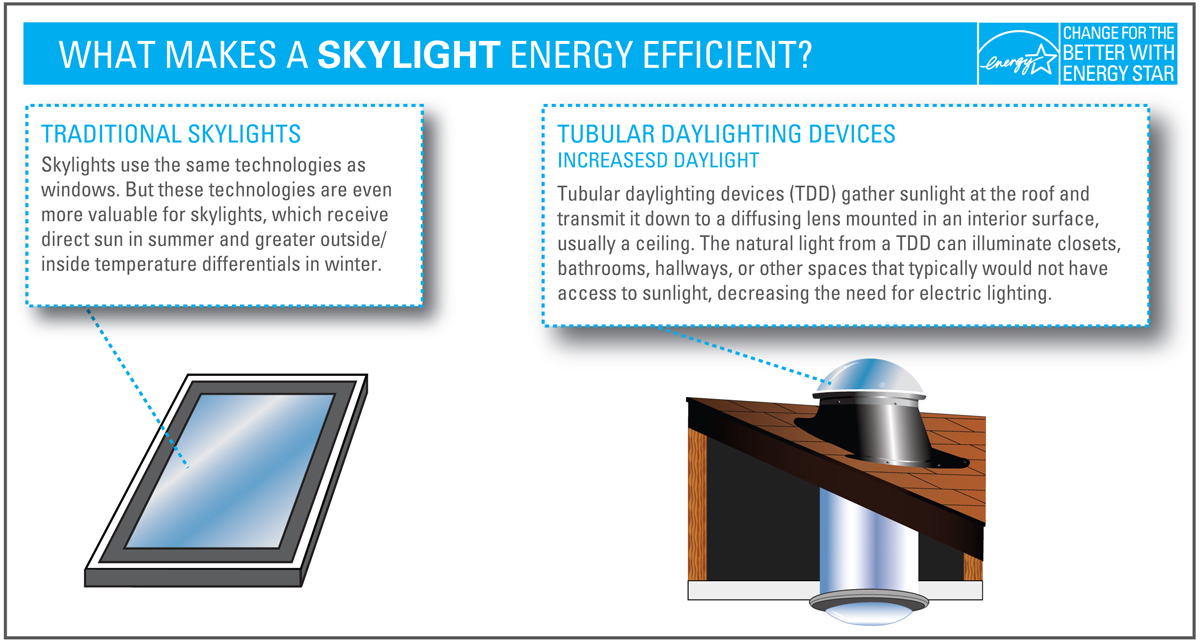
Figure \(\PageIndex{1}\): Skylights and solar tubes (tubular daylighting devices, TDD). While skylights resemble windows that are installed in the ceiling, solar tubes use lenses and a reflective lining to concentrate sunlight, providing bright illumination for darker parts of the home. What makes a skylight energy efficient? Traditional skylights are skylights that use the same technologies as windows, but these technologies are even more valuable for skylights, which receive direct sun in summer and greater outside/inside temperature differentials in winter. Tubular daylighting devices gather sunlight at the roof and transmit it down to a diffusing lens mounted in an interior surface, usually a ceiling. The natural light from a TDD can illuminate closets, bathrooms, hallways, or other spaces that typically would not have access to sunlight, decreasing the need for electric lighting. Left image by U.S. Department of Energy (public domain), and right image by Energy Star (public domain).
Solar energy can also be used as heat, which can be maximized through careful architecture (figure \(\PageIndex{2}\)). Firstly, the building requires south-facing windows (or glass doors). As sunlight passes through these areas, the energy is stored in the thermal mass of the building. This refers to heat trapping materials such as rock or tiles. The building is also designed such that heat is then distributed throughout the building. Finally, roof eaves or similar structures block sunlight from entering the home during the summer.
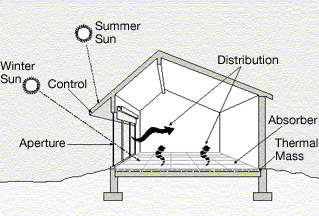
Figure \(\PageIndex{2}\): This building design uses the sun for heating during the winter and is thus a passive solar technology. The roof overhang serves as a control, blocking the higher summer sun while allowing the lower winter sunlight to pass through the window (aperture). Heat energy from the sun is then distributed in the building. Thermal mass (such as a tile or stone floor) absorbs and later releases heat energy. Image by U.S. Department of Energy (public domain).
A simple solar water heater is a passive technology consisting of a network of tubes that are heated by the sun (figure \(\PageIndex{3}\)). The hot water is then transferred through the plumping of a home. (Some solar water heaters are more complex, using pumps, and are thus considered active solar technologies.)
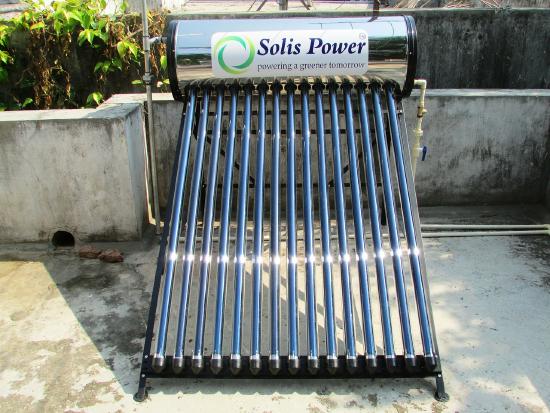
Figure \(\PageIndex{3}\): A solar water heater. Image by Vijayanarasimha/Pixabay (public domain).
Active solar technologies are more complex. For example, solar panels use light energy to generate electricity (figure\(\PageIndex{4}\)). This occurs in the units of the solar panel, which are called photovoltaic cells (PV cells; figure\(\PageIndex{4-5}\)). Each photovoltaic cell consists of two layers of semiconductors, substances that only conduct electricity under certain circumstances. (In contrast, conducts always conduct electricity, and insulators do not.) One semiconductor has extra electrons, but the other has extra spaces for electrons. When light shines on the photovoltaic cell, it causes electrons to move from between semiconductor layers through the conductor that connects them (such as metal wires or plates). This movement results in an electric current.
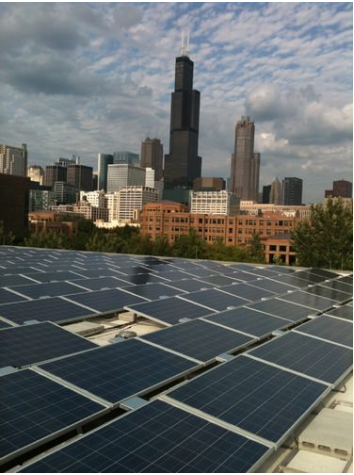
Figure \(\PageIndex{4}\): Rooftop solar installation on Douglas Hall at the University of Illinois at Chicago has no effect on land resources, while producing electricity with zero emissions. Source: Office of Sustainability, UIC
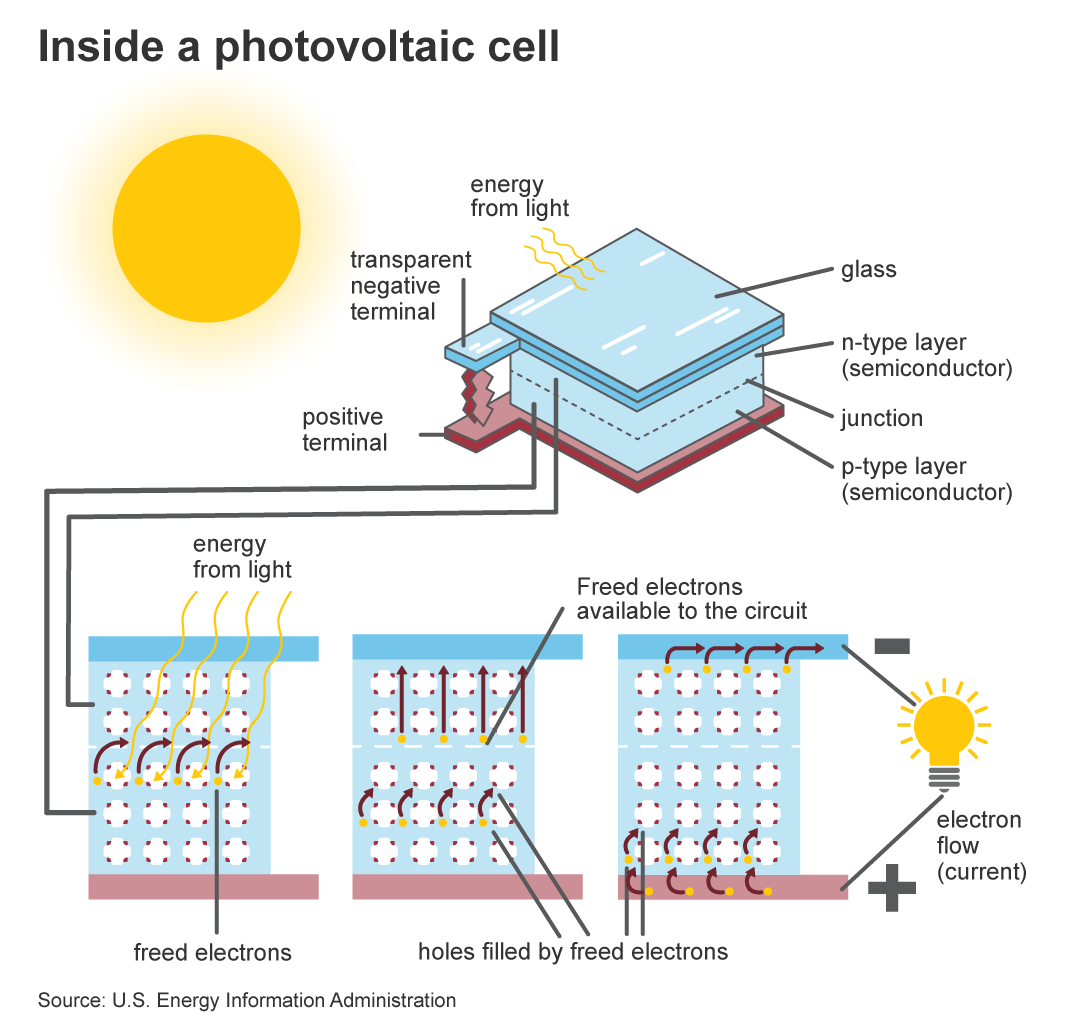
Figure \(\PageIndex{5}\): Diagram of a photovoltaic cell consisting of two layers of semiconductors. The top (n-type) semiconductor has extra electrons and the bottom (p-type) semiconductor has extra spots (holes) for electrons. A junction divides these two layers. Light frees the electrons and allows them to move through a wire from the n-type to fill "electron holes" in the p-type semiconductor. The movement of electrons through the wire results in an electrical current. Image by U.S. Energy Information Administration (public domain).
This video explains how the photovoltaic cells within solar panels generate electricity.
Another example of active solar technology is solar thermal technology. This involves using a series of mirror to concentrate solar energy, ultimately generating steam. From there, the steam turns a turbine and powers a generator (figure\(\PageIndex{6}\)).
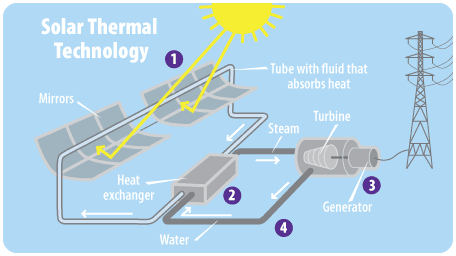
Figure \(\PageIndex{6}\): In solar thermal technology, (1) mirrors or reflectors concentrate the sun's rays to heat a special kind of liquid, which absorbs heat. (2) The heat from this liquid boils water to create steam, facilitated by the heat exchanger. (3) Steam spins a turbine that is connected to a generator, which creates electricity. (4) The steam cools and condenses back to water, which is recycled, reheated, and converted into steam again. Image and caption (modified) from EPA (public domain).
Solar energy is by far the most plentiful renewable source of energy, delivered to the surface of the earth at a rate of 120,000 Terawatts (TW), compared to the global human use of 15 TW. To put this in perspective, covering 100×100 km2 of desert with 10% efficient solar cells would produce 0.29 TW of power, about 12% of the global human demand for electricity. To supply all of the earth’s electricity needs (2.4 TW in 2007) would require 7.5 such squares, an area about the size of Panama (0.05% of the earth’s total land area). The world’s conventional oil reserves are estimated at three trillion barrels, including all the oil that has already been recovered and that remain for future recovery. The solar energy equivalent of these oil reserves is delivered to the earth by the sun in 1.5 days.
Not only is solar energy abundant, but the use of solar panels for electricity does not generate air pollution or contribute to climate change. (The manufacture of solar panels can generate some pollution, including greenhouse gas emissions, but this is minimal compared to that of fossil fuels.) Like wind energy, expansions on solar energy can create jobs and boost economies. Also like wind, sunlight is intermittent and storage of solar energy is limited by battery capacity. Some locations do not receive consistently direct sunlight and are ill-suited for solar panels. While solar energy has historically been the most expensive form of renewable energy, new technologies have lowered its cost.
The geographical distribution of useable renewable solar energy is quite uneven, concentrated in deserts where cloud cover is rare. The solar resources of the United States, Germany and Spain are compared in Figure \(\PageIndex{7}\). The solar irradiation in the southwestern United States is exceptional, equivalent to that of Africa and Australia, which contain the best solar resources in the world. Much of the United States has solar irradiation as good or better than Spain, considered the best in Europe, and much higher than Germany.
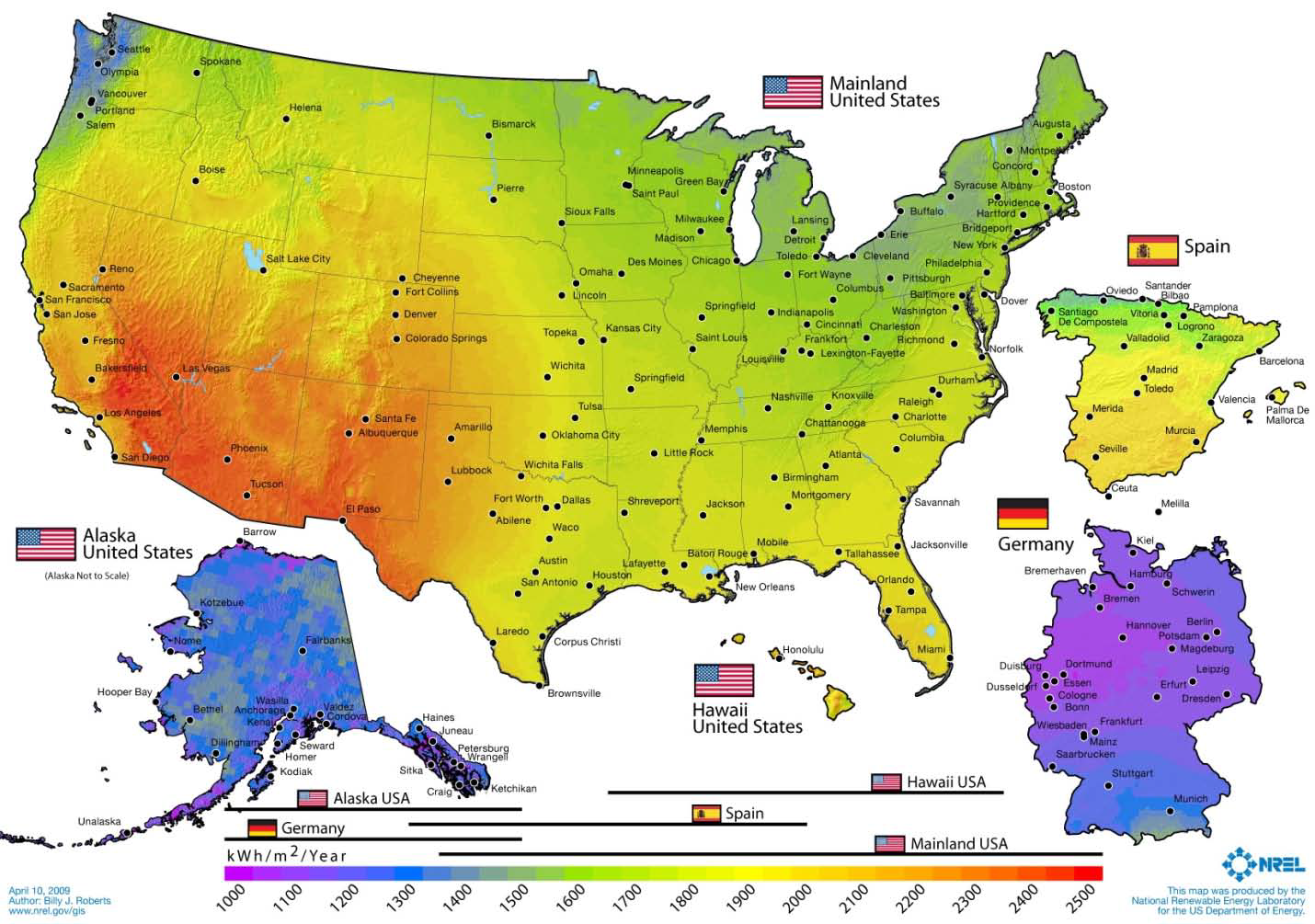
Figure \(\PageIndex{7}\): Figure Solar Resources of the United States, Spain and Germany The solar resources of the United States, Spain and Germany, expressed as solar insolation averaged over the year. The geographic variation of solar irradiation in the United States is only a factor of two, much less than for other renewable energy sources. Source: U.S. Department of Energy, Energy Efficiency and Renewable Energy, 2008 Solar Technologies Market Report, DOE/GO-102010-2867 (January, 2010), p52.
The placement of solar panels determines how their environmental impact. Solar arrays are often placed on roofs of buildings or over parking lots or integrated into construction in other ways. However, large systems may be placed on land and particularly in deserts where those fragile ecosystems could be damaged if care is not taken. Additionally, solar farms can compete for agricultural space.
Other downsides of solar energy are water consumption (for some uses) and generation of hazardous wastes. Large networks of mirrors and lenses that concentrate solar energy for electricity generation in thermal solar systems or for heating may need to be cleaned regularly with water. Water is also needed for cooling the turbine-generator. Using water from underground wells may affect the ecosystem in some arid locations. The manufacturing of photovoltaic cells generates some hazardous waste from the chemicals and solvents used in processing. Some solar thermal systems use potentially hazardous fluids (to transfer heat) that require proper handling and disposal. Nuclear power exceeds solar energy in water consumption and hazardous waste generation, however.
Attribution
Modified by Kyle Whittinghill and Melissa Ha from the following sources:
- Renewable Energy and Challenges and Impacts of Energy Use from Environmental Biology by Matthew R. Fisher (licensed under CC-BY)
- Essentials of Environmental Science by Kamala Doršner is licensed under CC BY 4.0.
- Renewable Energy: Solar, Wind, Hydro and Biomass in Sustainability a Comprehensive Foundation by Tom Theis and Jonathan Tomkin


